| Pages:
1
2
3
4 |
12AX7
Post Harlot
    
Posts: 4803
Registered: 8-3-2005
Location: oscillating
Member Is Offline
Mood: informative
|
|
The mathematics of pulse sharpening say, very roughly, you need to have the entire input (rising edge) inside the line before it can do anything. If
the edge is slower than the line's electrical length, it simply won't do anything, it will act like a boring wire. The point is, you need to cram the
supply's energy into the line, and it has to hold that energy and do whatever to it (meanwhile, no energy is going in or out), then release the energy
after it's done whatever it does.
Since velocity factor is much lower (less than 0.1c), an electrical length of 1 microsecond is actually quite short physically. That's one nice
thing. Still, you want to minimize how much you need, and you do that by minimizing input risetime.
Tim
|
|
|
watson.fawkes
International Hazard
    
Posts: 2793
Registered: 16-8-2008
Member Is Offline
Mood: No Mood
|
|
Quote: Originally posted by 12AX7  | | The mathematics of pulse sharpening say, very roughly, you need to have the entire input (rising edge) inside the line before it can do anything. If
the edge is slower than the line's electrical length, it simply won't do anything, it will act like a boring wire. The point is, you need to cram the
supply's energy into the line, and it has to hold that energy and do whatever to it (meanwhile, no energy is going in or out), then release the energy
after it's done whatever it does. |
Now don't go all action-at-a-distance on us. I appreciate the desire for a
summary description, bu energy storage is a little misleading, although not totally inaccurate. There's energy in the electric fields of the pulse, to
be sure, and all that energy might be contained in your line at one time, but the actual mechanism of sharpening doesn't require the whole pulse to be
in the line all at one time. If it's not, you might get incomplete sharpening, to be sure, but not zero sharpening.
What's really going on here is that the pulse is sharpening at the same time at it's propagating. If you don't have length enough to get much time for
propagation, you don't get much sharpening. Sharpening happens purely locally; there's no need to invoke operations on the pulse as a whole. The full
mathematics uses variational calculus to find an attractor in a class of (propagating) pulse functions. This is essentially what a soliton is. What's
interesting is that you get particular pulse envelope shapes out of a local interaction. The field is both abstruse and relatively arcane; look up
"integrable systems" and the Korteweg-de Vries equation for a start.
Incidentally, the most widely-known pulse sharpening in nature is the breaking of ocean surf. | Quote: | | Since velocity factor is much lower (less than 0.1c), an electrical length of 1 microsecond is actually quite short physically. That's one nice
thing. Still, you want to minimize how much you need, and you do that by minimizing input risetime. |
I read
the strontium barium titanate paper that not_important posted. That's an impressive material. At it's maximum (about 57° C), it's got a
relative dielectric constant of 14,500 and relative tunability to 5 kV/cm of 55%. In the present hypothetical, that means that the "top" piece of the
pulse at 5 kV/cm travels sqrt(1/(1-55%)) ~= 1.5 times faster than its "bottom" (near zero field). OK, that's a gross approximation, but it will allow
a quick and dirty estimate. Suppose you had a delay line one meter in length with this material as dielectric, which is within the capacity of a
dedicated amateur. Mind you, this is inside a thermostatic oven to reach this performance. You can introduce the top of the pulse when it's base is
1/3 of the way in and the top and bottom will meet it at the end. (Not really, but this is just an estimate. It doesn't sharpen quite this fast.) 1/3
of a meter at a propagation speed of c/sqrt(14500) is about 134 ns. A pulse of this rise time (approximately, I stress) or shorter will be as sharp as
the dielectric allows at the end of the line.
Hmm. This is doable. Not useful for EBW, but anybody want a nice e-beam pulse generator?
|
|
|
12AX7
Post Harlot
    
Posts: 4803
Registered: 8-3-2005
Location: oscillating
Member Is Offline
Mood: informative
|
|
Quote: Originally posted by watson.fawkes  | | Now don't go all action-at-a-distance on us. I appreciate the desire for a summary description, bu energy storage is a little misleading, although not
totally inaccurate. There's energy in the electric fields of the pulse, to be sure, and all that energy might be contained in your line at one time,
but the actual mechanism of sharpening doesn't require the whole pulse to be in the line all at one time. |
Ah, but I specified edge. If that's what you meant by pulse, then fair enough.
Of course, if you don't shove the whole thing in but only a little (i.e. a 'too short' line, or 'too slow' edge), it only sharpens it as much as it
can (operating on, very roughly, only what it's been fed to that time). And, at any given point along the line, the pulse gets an increasingly tall
discontinuity in it as the shockwave builds. These kinds of things always have to be continuous, there is no wire / transmission-line duality, only
some of one or the other. And this is what you go on to state (snipped).
| Quote: |
[more snip]
1/3 of a meter at a propagation speed of c/sqrt(14500) is about 134 ns. A pulse of this rise time (approximately, I stress) or shorter will be as
sharp as the dielectric allows at the end of the line.
Hmm. This is doable. Not useful for EBW, but anybody want a nice e-beam pulse generator? |
Neeto. I'd use a small one for a sampling oscilloscope. Hmm, ya know, such a line has a sick amount of delay. You'd never be able to "trigger" it
for infrequent waveforms (like...other pulse generators!), not without a horrendously long delay line in the signal path (>100ns). I suppose if
you drive it with a cheap 10ns source (bus driver logic chips?) you can use a much shorter line which would be acceptable (an acceptable delay is
under 50ns, your average analog scope has about that much delay in its amplifiers).
Tim
|
|
|
watson.fawkes
International Hazard
    
Posts: 2793
Registered: 16-8-2008
Member Is Offline
Mood: No Mood
|
|
Quote: Originally posted by 12AX7  | | Neeto. I'd use a small one for a sampling oscilloscope. [...] I suppose if you drive it with a cheap 10ns source (bus driver logic chips?) you can
use a much shorter line which would be acceptable (an acceptable delay is under 50ns, your average analog scope has about that much delay in its
amplifiers). |
If all you're after is the delay, then you can drive it at any voltage. On the other hand, the
pulse-sharpening non-linearity happens only when you're driving it at adequate field strengths, up in the kV/cm range. You can get this at low
voltages with microfabrication, admittedly, but that's starting to require real gear.
|
|
|
12AX7
Post Harlot
    
Posts: 4803
Registered: 8-3-2005
Location: oscillating
Member Is Offline
Mood: informative
|
|
In oscilloscope design, the problem is how soon you can trigger the display (be it a sampling device or another scan of the CRT) after detecting the
synchronizing event. There has to be some propagation delay here (comparators, logic and such), so you must have a delay line between input and
sampling to compensate. The delay is usually just a roll of low-loss coax cable, followed by a filter and preamp to compensate for its HF loss.
The problem with a shock line is, it's inherently a wad of delay, so you want to minimize its length, so as to also minimize the amount of signal
delay needed.
Tim
|
|
|
watson.fawkes
International Hazard
    
Posts: 2793
Registered: 16-8-2008
Member Is Offline
Mood: No Mood
|
|
For that application, you'll want to
minimize the non-linearity in order to minimize signal distortion. To use SrBi-TiO3 (you might pick another high-epsilon material), you'd want to make
a rather large distance between conductors in order to keep the electric field in the dielectric low. Propagation speed doesn't depend on the
conductor gap, though, so you can design that separately. Impedance is going to be quite low compared to other coax, too, since that scales down by
the same 1/sqrt(epsilon) factor.
As for fabrication, I think the easiest form factor is, indeed coax, with the dielectric in the shape of cored-cylinder beads. With beads, you don't
have to worry about a delicate, long element. The ends of the bead must match up flush, which might require a little grinding. And with beads, it's
easy to tune the exact length of the line to suit.
|
|
|
12AX7
Post Harlot
    
Posts: 4803
Registered: 8-3-2005
Location: oscillating
Member Is Offline
Mood: informative
|
|
Coax (the plastic filled kind) is usually used for high quality delay lines. My Tektronix 475 has a big coil of hardline just below the CRT. It
connects between the preamps and signal switching stuff and the vertical output driver.
So you'd use a quality coax for the signal delay and a shock line for the pulse generator (with its inherent delay).
As shock lines go, it would be very easy to buy a couple hundred ferrite beads, string them on a piece of wire and string the 'necklace' into a copper
tube. High permeability ferrites are as easy to come by as high permittivity dielectrics, with the advantage that they're readily available in
convienient forms, like beads. Being a magnetic shockwave, current (instead of voltage) will have a discontinuity, which will still look like a big
fat step (V and I) when fed into a resistive line.
Hmm, an electric shock line's impedance is reduced, but a magnetic shock line's impedance is increased. If you build a 50 ohm coax line and load it
with ferrite, you might end up with 500 ohms instead, no? Either case is difficult to match with regular 50 ohm coax. 500 ohms at least is easier to
match with 300 or 600 ohm twin lead; a low impedance like 5 ohms would need a transformer to be at all useful.
Hmm, 5 ohms. That's low, isn't it. It might actually be capable of zapping a bridgewire. And a thousand ceramic chip caps can store plenty of
energy (even if that energy density drops at the high voltages seen in a shock line). If you get 1000 x 0.1uF 50V with Z5U dielectric, you might have
50uF at 50V or 62.5mJ storage. I'm guessing capacitance drops roughly proportional to voltage, so energy is closer to linear or constant with respect
to voltage, so you wouldn't get too much more energy than this from a full shock.
Tim
|
|
|
watson.fawkes
International Hazard
    
Posts: 2793
Registered: 16-8-2008
Member Is Offline
Mood: No Mood
|
|
Quote: Originally posted by 12AX7  | | Hmm, an electric shock line's impedance is reduced, but a magnetic shock line's impedance is increased. If you build a 50 ohm coax line and load it
with ferrite, you might end up with 500 ohms instead, no? Either case is difficult to match with regular 50 ohm coax. 500 ohms at least is easier to
match with 300 or 600 ohm twin lead; a low impedance like 5 ohms would need a transformer to be at all useful. |
You're about an order of magnitude off in each direction. It's OK. I was surprised to see just how large the permittivity was; it
gives very much out-of-the-ordinary values for components. As for low impedance with high-permittivity dielectic, you're looking at about an ohm: 1.15
ohms for epsilon=14.5E3, mu=1, D/d=10. For high-impedance with ferrite, it's 9.76 kilohms for mu=5E3, epsilon=1, D/d=10. (And that's fairly cheap
ferrite.)
It's occurred to me that if you had beads of each kind of material of equal inner and outer diameters, in a selection of trimmable lengths, that there
are some astonishing passive filtering networks you could build in very small spaces. Each change of material would correspond to another L + C pair
in your filter network.
|
|
|
dann2
International Hazard
    
Posts: 1523
Registered: 31-1-2007
Member Is Offline
Mood: No Mood
|
|
Hello,
@Franklyn
Where did the diagram showing capacitor construction, that you posted above, come from? I cannot find the source.
Book available in References, Books needed by members:
Post of 12 Aug 2009. Explosives engineering. Links below:
http://www.mediafire.com/?sharekey=360ede2910eecf1224a64199a...
and
http://www.megaupload.com/?d=0DIJE7NC
Thanks to Jokull.
Page 369 of PDF has lots of info. on exploding bridge wires + cables, times, powers etc etc.
Dann2
[Edited on 12-8-2009 by dann2]
[Edited on 12-8-2009 by dann2]
|
|
|
franklyn
International Hazard
    
Posts: 3026
Registered: 30-5-2006
Location: Da Big Apple
Member Is Offline
Mood: No Mood
|
|
High Voltage Engineering
http://ifile.it/96lravq
A very nice book short and to the point. This is an introductory text intended for
utility power engineers , so examples refer to characteristically high line voltages.
See the pictures of test equipment just before Chapter 3 which concisely deals
with pulses. Was I lying when I said , when you use Hi Voltage everything is HUGE.
One could generate equivalent power at 1/1000 the voltage and reduce the size of
equipment to 1/10 th ( cube root of 1000 , in other words increasing the voltage
by 1000 increases equipment size by 10 times at least ) High voltage is a requirement
only for - long distance - power transmission , or in this case , for test purposes.
Below is attached some excerpts from the pdf pages 93 & 94 which succintly states
some of what I have been relating here ad nauseam.
________________________________________________________________
Also below is attached a chart which compares the thermal enthalpy of metal wires
of the same size ( I don't remember the mil gauge ). It is evident why gold is prefered
since copper requires 3 times the energy to explode , and aluminum 5 times as much !
From this reference I already gave before _
EBW1 - a computer code for the prediction of the behavior of electrical circuits containing exploding wire elements
http://www.osti.gov/energycitations/servlets/purl/4229184-1IbmTb
________________________________________________________________
I just now noticed I had posted the URL's with http;// shown twice , so they are
correctly shown here now _
Scaling Underwater Exploding Wires
http://handle.dtic.mil/100.2/AD633115 , This redirects to the next link below
http://www.dtic.mil/cgi-bin/GetTRDoc?AD=AD633115&Location=U2&am...
Formation & Evolution of Plasmas from Single Exploding Wires
http://www.prod.sandia.gov/cgi-bin/techlib/access-control.pl/2002/0...
This one is just ridiculus _
Exploding Wire Initiation
http://ntrs.nasa.gov/archive/nasa/casi.ntrs.nasa.gov/19690013624_1969013624.pdf
Read last paragraph of ' General system description ' page 2 , note the time scale for discharge.
Oscillographic & Schlieren-streak Photographic Investigations of an Exploding Wire Discharge
http://www.physics.re.kr/resource/wop.pdf/J01/1984/017/R02/J0119840...
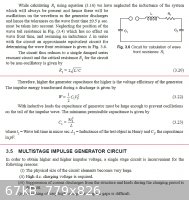 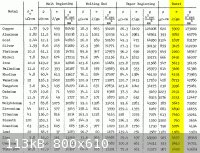
|
|
|
franklyn
International Hazard
    
Posts: 3026
Registered: 30-5-2006
Location: Da Big Apple
Member Is Offline
Mood: No Mood
|
|
On High Energy Density Pulse Power Devices and Physics
http://www.fas.org/sgp/othergov/doe/lanl/pubs/00285643.pdf
High Energy Density Ferroelectric Ceramics for Explosive Pulsed Power Applications
http://www.smdc.army.mil/FactSheets/FEG.pdf
.
|
|
|
dann2
International Hazard
    
Posts: 1523
Registered: 31-1-2007
Member Is Offline
Mood: No Mood
|
|
Hello Folks,
Thought I'd kick this old chestnut around again.
<b>As stated in another thread, I hereby detract anything I said about needing low inductance capacitors for the application of exploding
bridgewire detonators</b>
The system is (usually) dominated by cable inductance. Use a good high Voltage to get around any inductance problems.
If Packman can do it, so can Dann2
Dann2
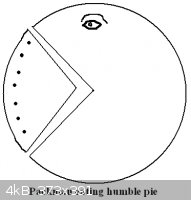
|
|
|
franklyn
International Hazard
    
Posts: 3026
Registered: 30-5-2006
Location: Da Big Apple
Member Is Offline
Mood: No Mood
|
|
A collection of do it yourself electrical improvisations by Darwin award contestants.
 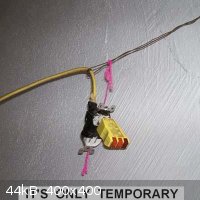 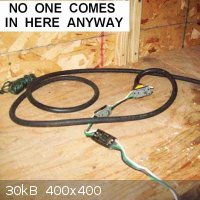 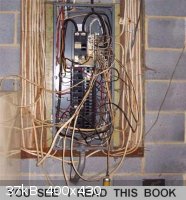
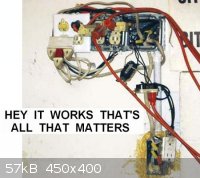 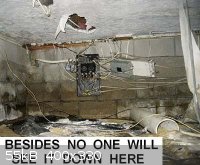 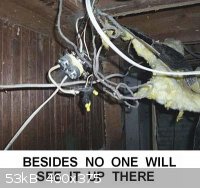 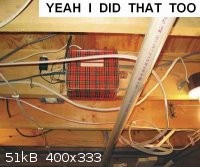
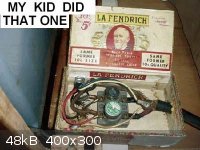 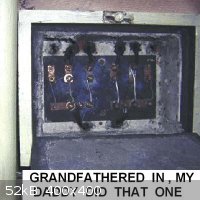
|
|
|
franklyn
International Hazard
    
Posts: 3026
Registered: 30-5-2006
Location: Da Big Apple
Member Is Offline
Mood: No Mood
|
|
A collection of do it yourself electrical improvisations by Darwin award contestants.
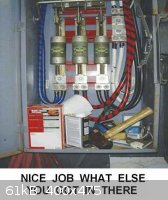 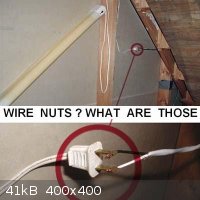 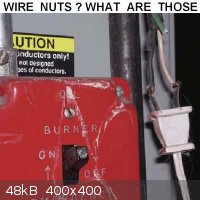 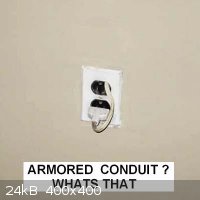
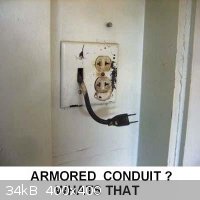 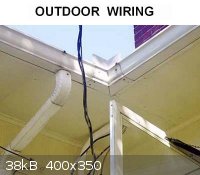 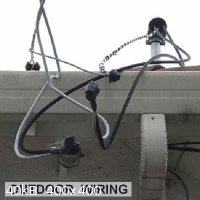 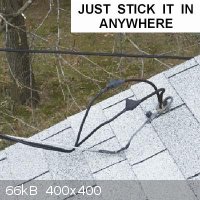
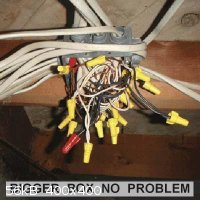 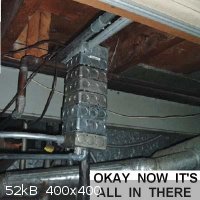
|
|
|
franklyn
International Hazard
    
Posts: 3026
Registered: 30-5-2006
Location: Da Big Apple
Member Is Offline
Mood: No Mood
|
|
A collection of do it yourself electrical improvisations by Darwin award contestants.
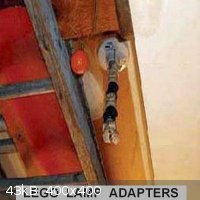 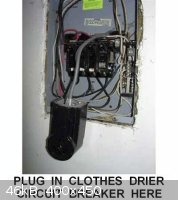
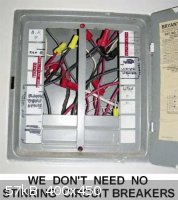 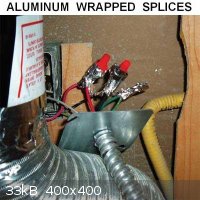
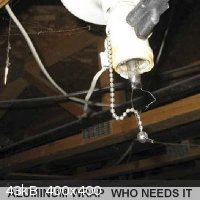 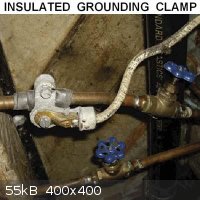
 
[Edited on 17-7-2011 by franklyn]
|
|
|
bbartlog
International Hazard
    
Posts: 1139
Registered: 27-8-2009
Location: Unmoored in time
Member Is Offline
Mood: No Mood
|
|
You have to actually off yourself to be a Darwin Award contestant. Most of that wiring, while not professionally done, likely both serves the intended
purpose and hasn't killed anyone yet.
|
|
|
franklyn
International Hazard
    
Posts: 3026
Registered: 30-5-2006
Location: Da Big Apple
Member Is Offline
Mood: No Mood
|
|
You have to off yourself to be an award winner ,
anyone can be a contestant.
Anyone who requires explaination of " what's wrong with this picture "
depicted above ought not play with electricity - seriously.
.
|
|
|
franklyn
International Hazard
    
Posts: 3026
Registered: 30-5-2006
Location: Da Big Apple
Member Is Offline
Mood: No Mood
|
|
Initiation of Explosives by Exploding Wires - I
Effect of Circuit Inductance on the Initiation of PETN by Exploding Wires
www.dtic.mil/dtic/tr/fulltext/u2/424518.pdf
Initiation of Explosives by Exploding Wires - I I
Effect of Circuit Resistence on the Initiation of PETN by Exploding Wires
www.dtic.mil/dtic/tr/fulltext/u2/431785.pdf
Initiation of Explosives by Exploding Wires - I I I
Effect of Wire Diameter on the Initiation of PETN by Exploding Wires
www.dtic.mil/dtic/tr/fulltext/u2/600058.pdf
Initiation of Explosives by Exploding Wires - I V
Effect of Wire Length on the Initiation of PETN by Exploding Wires
www.dtic.mil/dtic/tr/fulltext/u2/601990.pdf
Initiation of Explosives by Exploding Wires - V
Effect of Wire Material on the Initiation of PETN by Exploding Wires
www.dtic.mil/dtic/tr/fulltext/u2/609449.pdf
Initiation of Explosives by Exploding Wires - V I
Further Effects of Wire Material on the Initiation of PETN by Exploding Wires
www.dtic.mil/dtic/tr/fulltext/u2/463360.pdf
Initiation of Explosives by Exploding Wires -V I I
Effect of Energy Termination on the Initiation of PETN by Exploding Wires
www.dtic.mil/dtic/tr/fulltext/u2/618675.pdf
Initiation of Explosives by Exploding Wires - V I I I
Survey to Determine Explosives Capable of Initiation at Moderate Voltage Levels
www.dtic.mil/dtic/tr/fulltext/u2/476199.pdf
Experiments and Simulations of Exploding Aluminum Wires
www.dtic.mil/dtic/tr/fulltext/u2/a565356.pdf
Thin Film Electric Initiator - I I I
Application of Explosives and Performance Tests
www.dtic.mil/dtic/tr/fulltext/u2/686281.pdf
Exploding Foil Techniques
www.dtic.mil/dtic/tr/fulltext/u2/873341.pdf
Electric Initiators : A Review of the State of the Art
www.dtic.mil/dtic/tr/fulltext/u2/266014.pdf
Bibliography of the Electrically Exploded Conductor phenomenon 4 th edition
www.dtic.mil/dtic/tr/fulltext/u2/662345.pdf
Exploding Foil Flying Plate Generator
www.dtic.mil/dtic/tr/fulltext/u2/a205157.pdf
Terminated Exploding Wire Energy Source
www.dtic.mil/dtic/tr/fulltext/u2/618478.pdf
Explosive Pulsed Power : An Enabling Technology
www.dtic.mil/dtic/tr/fulltext/u2/a504423.pdf
Fuzing & Firing Systems at Sandia National Laboratories
www.dtic.mil/ndia/2009fuze/IIbutler.pdf
Application of P.W. Bridgman's ' New EMF ' to Exploding Wire Phenomena
www.dtic.mil/dtic/tr/fulltext/u2/602913.pdf
.
|
|
|
jock88
National Hazard
   
Posts: 505
Registered: 13-12-2012
Member Is Offline
Mood: No Mood
|
|
Would a device like this http://www.elephant.as/index.php?page=shop.product_details&a...
succeed in detonating EBW's. They have sufficient voltage. Joules per pulse is OK. (3 OR 4 afaik).
Don't know how fast the rising edge is.
They are not too cheap but ready off the shelf.
Herd cows and explode EBW's with one device. Now thats an unusual selling point.
With exploding bridge foil detonators. How does the foil 'know' what direction to fly in?
Useful patent.
0.5 joules, 500 Volts.
[Edited on 24-12-2012 by jock88]
Attachment: US3040660.pdf (121kB)
This file has been downloaded 859 times
|
|
|
franklyn
International Hazard
    
Posts: 3026
Registered: 30-5-2006
Location: Da Big Apple
Member Is Offline
Mood: No Mood
|
|
" Don't know how fast the rising edge is."
Assuming average power supplies energy in excess for the mass of wire to be vaporized ,
as you note , the rise time of a discharge is what determines if it's capable of exploding a wire.
On the order of a billion amps per second , a million amps per millisecond , 1000 amps per
microsecond , with reliability , although success is achievable with a tenth of this value.
" With exploding bridge foil detonators. How does the foil 'know' what direction to fly in ? "
In the simple case it works just as the arc of Jacob's ladder here below

It's basically a miniature railgun so it will behave as this diagrams shows.

In large scale proportionally energized , the effect is just as dramatic.
www.youtube.com/watch?v=C6cV10QEGGk
( again in the simple case , this need not be true in situations where the conductors fold
back parallel to those holding the bridge , the position of the bridge in a given geometry
will determine the direction. This is not easily calculated and is definitively determined
empirically. There is much controversy about what is the applicable theory. )
http://pre.aps.org/abstract/PRE/v58/i2/p2505_1
http://pre.aps.org/abstract/PRE/v62/i5/p7544_1
http://pre.aps.org/abstract/PRE/v62/i5/p7545_1
http://pre.aps.org/abstract/PRE/v63/i5/e058601
http://pre.aps.org/abstract/PRE/v63/i5/e058602
That is the patent belatedly issued to Lawrence H. Johnston for his development
of the exploding bridgewire system that saw first use in implosion atomic bombs.
http://bit.ly/V0Ssck
.
|
|
|
bfesser
|
Thread Split
8-7-2013 at 17:58 |
sparkelectroinc
Harmless

Posts: 1
Registered: 21-8-2018
Member Is Offline
|
|
we can supply rogowski coil if you want, we are the leader of rogowski coil in China,
|
|
|
AJKOER
Radically Dubious
    
Posts: 3026
Registered: 7-5-2011
Member Is Offline
Mood: No Mood
|
|
I offer a pure chemical perspective with respect to exploding electronics for completeness, even if the argument is weak. There may be also a
composite chemical change and electronic aspect.
First, assuming the presence of high temperature exposure of metals in air, a possible formation of a nitride for select metals (and also an oxide
which may form an alkaline solution with atmospheric water condensation).
This source provides a list of possibly problematic nitrides at https://books.google.com/books?id=f1p-DAAAQBAJ&pg=RA1-PA... . A search of a pdf of Bretherick's Handbook of Reactive Chemical Hazards, 6th
Edition, Vol 1, indicates explosive properties for Ag3N, Au3N2.3H2O, tellurine nitride, Cd3N2, Na3N, SbN, Thallium (l) nitride (TlN), Pb3N2, S4N2,
Se4N2, (Si2N2)n, Te3N4, and Te4N4.
Of note, many early mentioned metals on the list of energetic compounds are also cited for their conductivity (see, for example, https://www.thebalance.com/electrical-conductivity-in-metals... ) .
[Also interestingly, per the Bretherick's Handbook, fine powdered Ca3N2 is claimed to be spontaneously flammable in air, copper nitride is said to
greatly increase the sensitivity of chlorate-sulfur mixtures, CoN is a pyrophoric powder and Cu(l) nitride reacts violently with acids]
Another cited example is the creation of porous lithium nitride, see https://link.springer.com/article/10.1007/s11668-015-0004-y and the MSDS on Lithium nitride, which notes that LiN3 is not compatible with Cu: https://nj.gov/health/eoh/rtkweb/documents/fs/1131.pdf .
I would go further to note that many metal nitrides plus condensed water may produce ammonia. Then, for example, H2O + NH3 + Cu + O2 + dust (a
possible source of metal oxides, which with water, could serve as an electrolyte) can lead to the creation of some NH4NO2 (see my comments at http://www.sciencemadness.org/talk/viewthread.php?tid=81755#... ), as a minor side reaction product, which usually rapidly decomposes except
perhaps at elevated pH (which would depend on any formed oxide and its reaction with water).
I would not be surprised, however, of modelling of electronic systems (to avoid electric driven explosions) failed to account for chemical changes
and possible reaction chains occurring on wires (composed of various metal alloys) heated in air over time.
[Edited on 24-8-2018 by AJKOER]
|
|
|
| Pages:
1
2
3
4 |